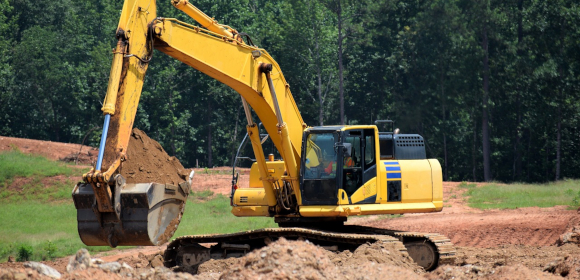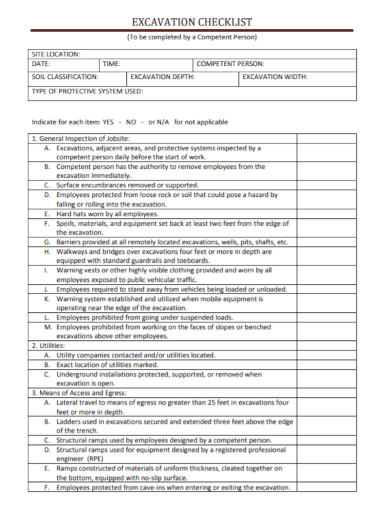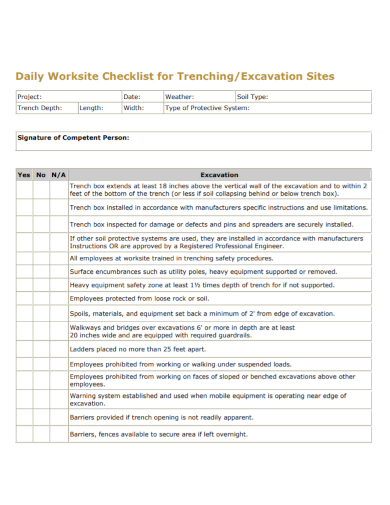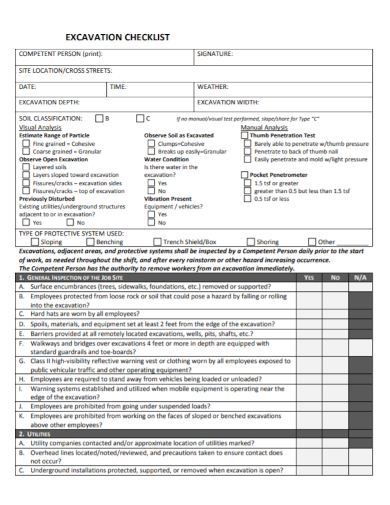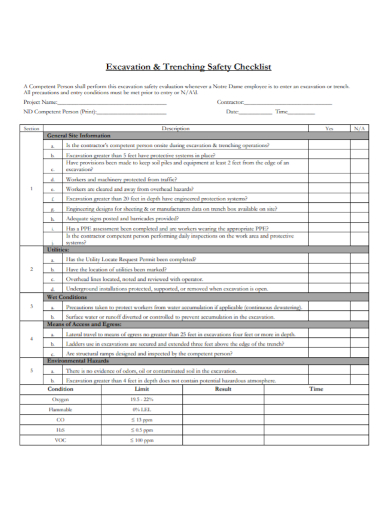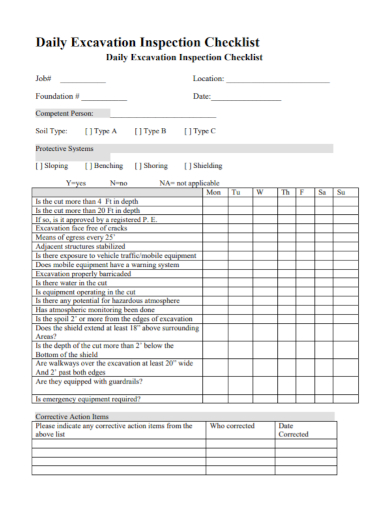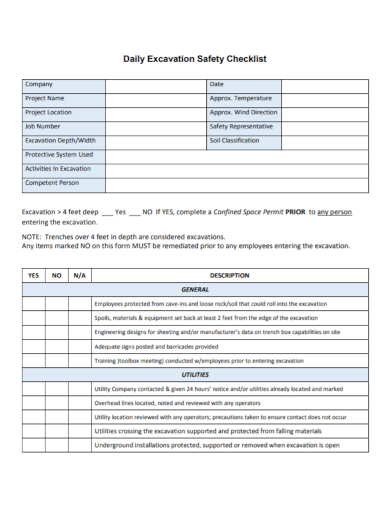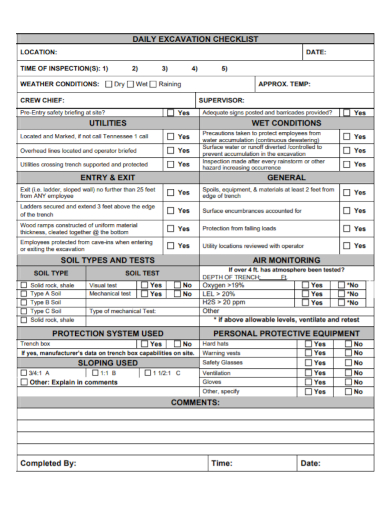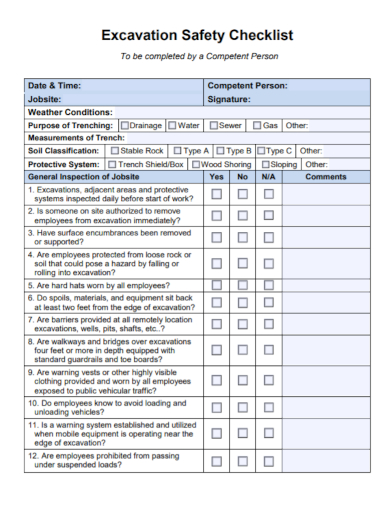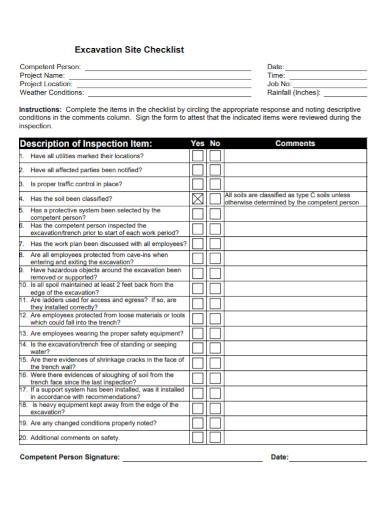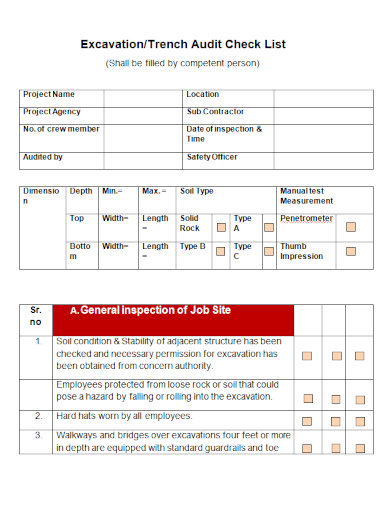Site safety has always been a main priority when it comes to excavation work. It is usually prone to cave-ins which is one of the major accidents and cause of injury or even death among workers in the construction industry. To be able to prevent incidents from happening in excavation sites, companies are asked to prepare an excavation checklist to make sure that all safety procedures has been followed. Check out our different excavation checklist samples to help you start off.
10+ Excavation Checklist Samples
1. Excavation Checklist Template
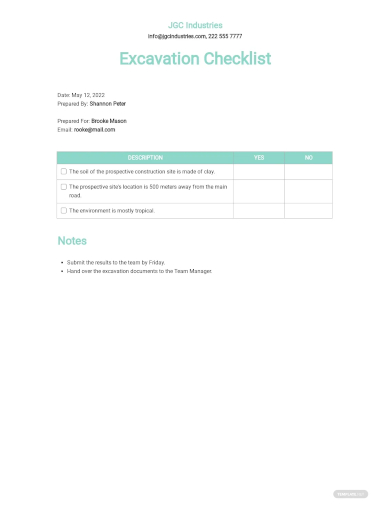
2. Excavation Checklist
3. Excavation Daily Worksite Checklist
4. Sample Excavation Checklist
5. Excavation Trenching Safety Checklist
6. Daily Excavation Inspection Checklist
7. Daily Excavation Safety Checklist
8. Daily Excavation Checklist
9. Excavation Safety Checklist
10. Excavation Site Checklist
11. Excavation Audit Checklist
What Is an Excavation Checklist?
In the construction industry, excavations is the process of removing objects usually soil, rocks or debris by the use of tools, high powered machinery and explosives. It is a highly risky job that poses a lot of danger thus excavation inspection is important. Precautionary measures are designed by site safety management to prevent accidents from occurring. Part of this safety measures is to make sure that all equipment, workers and the site itself are secure enough to work with. All these are must be written down in excavation checklist.
How to Create an Excavation Checklist?
An excavation checklist can be used to facilitate the set up and operation of the excavation work process. Since lot of conditions has to be taken in consideration before, during and after the whole excavation work. To make sure these are all covered, below are some key points to consider in creating a excavation checklist.
I. Site Inspection
Evaluate the area first to check if it is safe to start an excavation work by surveying the ground and top levels, identifying the soil type and locate underground utilities such as cables and pipes. Make sure then to mark the location of these and relay that information to the machine operators to prevent damaging the area.
II. Planning and Coordinating the Excavation Work
First, see to it that workers has undergone training and information has been properly disseminated. Make sure to identify the the hazards and measures to be taken. Then information should include the the work flow process and safety procedures to be followed and strictly observed. Conduct construction risk assessment for work that is not designated as high risk construction work.
III. Excavation Work Set Up
Next step is to set up the area or site, again there are things to be considered such as control measures in place to prevent injury to workers and members of public. Check if installation of ground support is needed and if there is a safe system of work in place to minimize the risk of injury from people installing and removing the system.
IV. Working in the Excavation site
As the work commences, ensure first and foremost that workers are equip with the right protective gear and tools. Before work begins, always check the surrounding areas and working conditions for any potential risk that might hinder operations. Prepare a risk management plan as this aid any disaster related incidents.
V. Excavation Inspection
Excavations can be unstable overtime, so it is essential that excavations should be inspected before the start of every work shift and even after the work ends. Check for any accidental fall of material which can affect strength and stability of the structure. This is a preventive measure to avoid future accidents from happening.
FAQs
What Is Trenching In Construction?
It is a method which involves digging and removing the dirt, forming a narrow depression into the ground like a trench and is mainly for installation, maintenance, or inspection of pipelines, conduits, or cables.
What Is Horizontal Directional Drilling?
A type of construction method that used to install pipes and cables without disturbing the soil or ground. This is a trenchless method which creates minimal impact on the surrounding environment. And often times used in areas that are protected due to their landscape, rich biodiversity, or historical value.
What Archaeological Excavation?
This is the process where archaeologist expose, record and retrieve cultural and archaeological remains found in the ground. Most of these are of great value and often have special handling techniques as not to contaminate or ruin these objects.
Excavation is a technique that plays a significant role in the construction process of every structure. This helps important structures be built to their fullest potential by providing increased control over the job location. However, this belongs to one of the most high risk working environment and profession. It is a working environment prone to enormous hazards and accidents. Although it is inevitable, construction safety and health are continually being imposed by companies to ensure their workers and the surrounding areas are safe and healthy. That is why regularly checking up with the help of a checklist is a constant reminder to take precaution always.
Related Posts
FREE 23+ Party Checklist Samples in MS Word | Google Docs | Apple Pages | PDF
FREE 18+ Scheduling Checklist Samples in MS Word | Google Sheets | PDF
FREE 17+ Response Checklist Samples in MS Word | Google Docs | PDF
FREE 17+ Survey Checklist Samples in MS Word | Google Docs | PDF
FREE 18+ Background Checklist Samples in MS Word | Google Sheets | PDF
FREE 18+ Facilitator Checklist Samples in MS Word | Google Sheets | PDF
FREE 18+ Complaint Checklist Samples in MS Word | Google Sheets | PDF
FREE 18+ Internship Checklist Samples in MS Word | Google Docs | PDF
FREE 18+ Statement Checklist Samples in MS Word | Google Sheets | PDF
FREE 20+ Voluntary Checklist Samples in MS Word | Google Sheets | PDF
FREE 18+ Summary Checklist Samples in MS Word | Google Sheets | PDF
FREE 14+ Sponsorship Checklist Samples in MS Word | MS Excel | PDF
FREE 18+ Conference Checklist Samples in MS Word | Google Sheets | PDF
FREE 17+ Lesson Checklist Samples in MS Word | Google Sheets | PDF
FREE 18+ Progress Checklist Samples in MS Word | Google Docs | PDF
